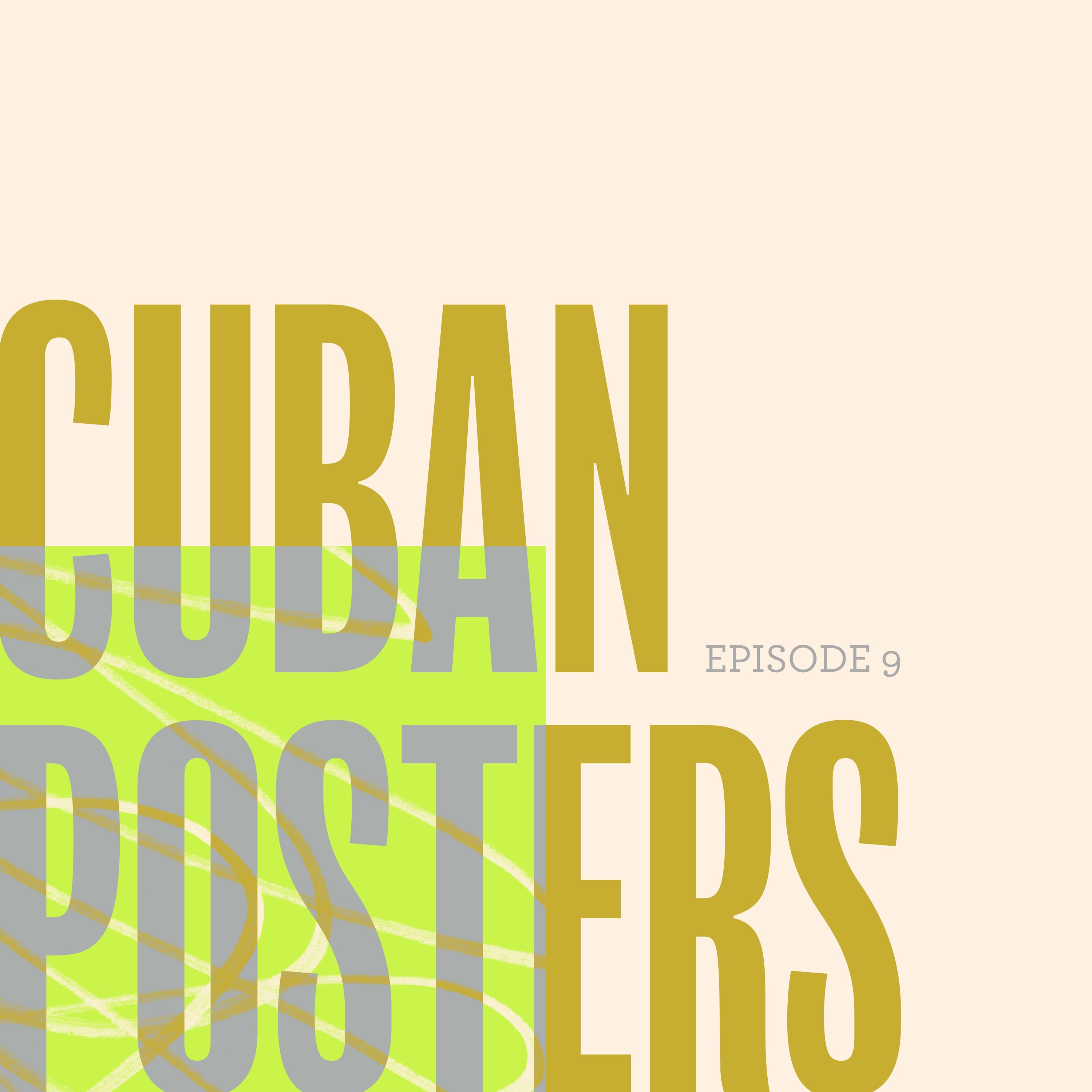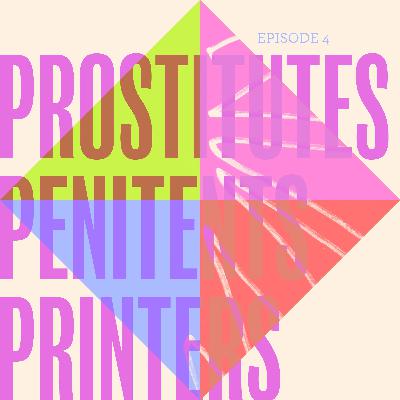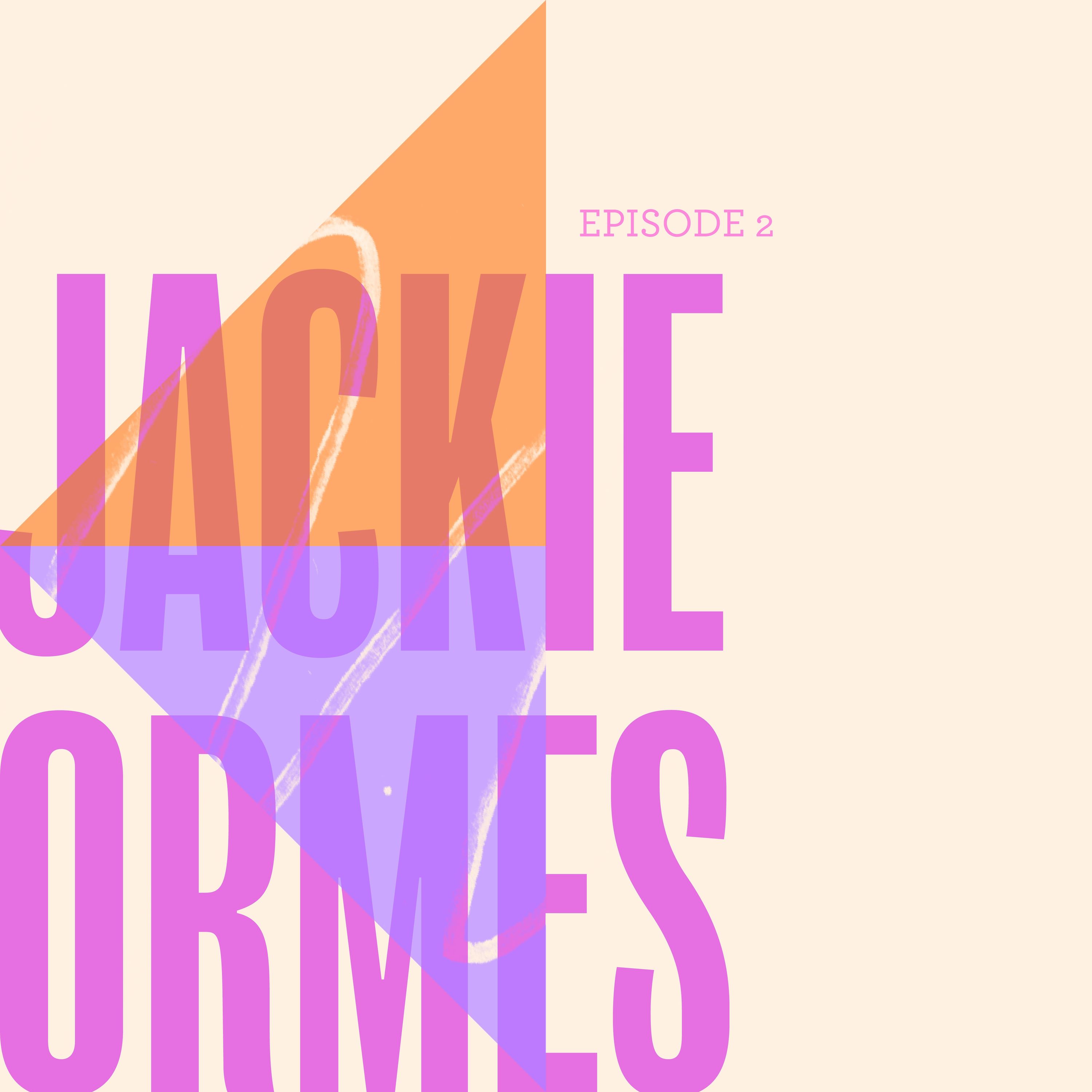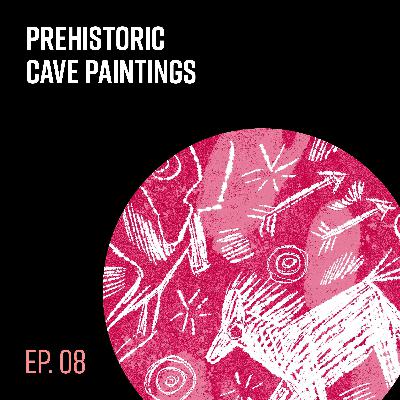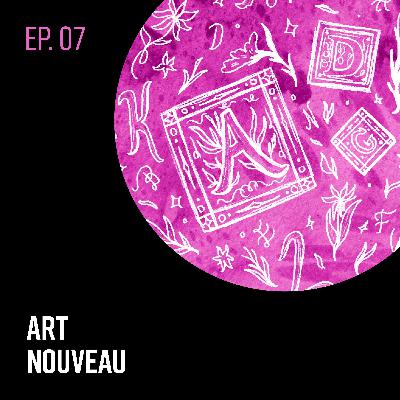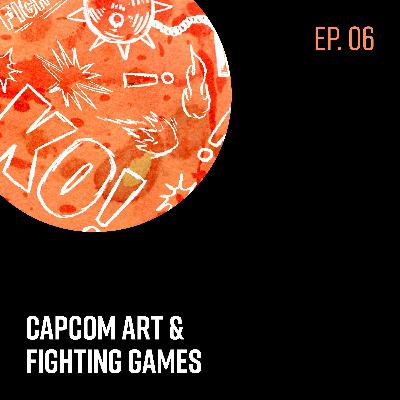Discover Incomplet Design History
Incomplet Design History

Incomplet Design History
Author: Amanda Horton
Subscribed: 9Played: 55Subscribe
Share
Description
The nature of history is that it is never “complete”, new information is gained every day that changes our understanding an interpretations of history. The mission of Incomplete Design History is to explore areas of graphic design history that are overlooked or ignored; to expand our knowledge in the field and to include all sides of the story. Incomplete design history seeks to be inclusive, inclusive not only of people but of ideas and technologies that advance the field of graphic design. History is messy. History is incomplete.
57 Episodes
Reverse
This episode examines the often-overlooked role of the mimeograph in the intertwined histories of print technology, graphic design, and social change. Emerging in the late nineteenth century through the innovations of Thomas Edison and Albert Blake Dick, the mimeograph offered an accessible, low-cost means of reproducing text and images—long before the advent of xerography or digital printing. Its simplicity and affordability placed the power of print into the hands of schools, churches, offices, and, crucially, grassroots organizations and independent creators. By the mid-twentieth century, mimeograph machines had become vital tools in the production of newsletters, pamphlets, and zines that fueled social movements and cultural revolutions. From the Civil Rights Movement’s underground newspapers to the literary explosion known as the Mimeo Revolution, the mimeograph democratized publishing and redefined the relationship between authorship, design, and distribution. Magazines such as The Floating Bear, Fuck You / A Magazine of the Arts, and The Yardbird Reader illustrate how writers and artists used the technology to challenge mainstream publishing, amplify marginalized voices, and experiment with form and content. Though ultimately replaced by photocopying and digital media, the mimeograph remains a critical link in the evolution of design and the politics of independent print culture.TIMELINE1876 - Thomas Edison patents the electric pen and duplicating press1881 - David Gestetner founds The Gestetner Cyclograph Company1884 - Albert Blake Dick incorporates as a lumber business1887 - The Edison Mimeograph Model 0 hits the market1891 - Samuel O’Reilly patents the first electric tattoo machine1898 - Neostyle Company introduces the first rotary mimeograph1906 - Gestetner opens a manufacturing plant in London1923 - Wilhelm Ritzerfeld invents the spirit duplicator1929 - Gestetner hires Raymond Loewy to redesign the cyclostyle1929-1930 - Yvor Winters publishes Gyroscope, the first mimeographed literary magazine1942 - Chester Carlson patents xerography1945 - WWII ends1955 - US involvement in Viet Nam begins1960 - The first xerox copier becomes commercially available1961 - The Floating Bear #1 is published1961 - Diane Di Prima and LeRoi Jones are arrested on obscenity charges1962 - SDS Port Huron Statement is published1962 - Ed Sanders publishes the first issue of Fuck You / a magazine of the arts1969 - BSU at Oregon State publishes the first Scab Sheet1971 - The Floating Bear publishes its final issue1972 - Yardbird Reader v. 1 is published1975 - Vietnam war ends1976 - The final Yardbird Reader is published1977 - Y-Bird v. 1 is published1980 - Risograph duplicators are released in JapanREFERENCESAlfred, R. (2008, August 8). Aug. 8, 1876: Run This Off on the Mimeo. WIRED. https://www.wired.com/2008/08/dayintech-0808-2/Ashawnta_Jackson. (2024). Exploring the Yardbird Reader. JSTOR Daily. https://daily.jstor.org/exploring-the-yardbird-reader/Clayman, A. (2025, January 9). A. B. Dick Company, est. 1884 - Made-in-Chicago Museum. Made-in-Chicago Museum. https://www.madeinchicagomuseum.com/single-post/ab-dick-company/Digital Collection - service/instruction manuals – Mimeograph Revival. (2024, October 18). Mimeograph Revival. https://www.mimeographrevival.com/manuals/Donley, K. (2014, November 22). stencil duplicator. MULTIMEDIAMAN. https://multimediaman.blog/tag/stencil-duplicator/Edison’s electrical pen and duplicating press. (1871). Mimeograph Revival. https://www.mimeographrevival.com/wp-content/uploads/2024/10/Edison-Electrical-Pen-and-Duplicating-Press.1876-Expo.pdfEinträge Archiv | Exploriso: Low-tech fine Art. (n.d.). Exploriso: Low-tech Fine Art. https://en.exploriso.info/exploriso/Floating Bear Archive. (2006, October 3). Reality Studio. https://realitystudio.org/bibliographic-bunker/floating-bear-archive/Gestetner Cyclostyle Office Duplication Machine Design by Raymond Loewy | Hagley. (n.d.). https://www.hagley.org/librarynews/gestetner-cyclostyle-office-duplication-machine-design-raymond-loewyHawley, H. (2006). Revaluing mimeographs as historical sources. RBM: A Journal of Rare Books, Manuscripts, and Cultural Heritage. https://rbm.acrl.org/index.php/rbm/article/viewFile/414/414Helland, M. (2024, February 24). THE HISTORY OF THE MIMEOGRAPH — International Printing Museum. International Printing Museum. https://www.printmuseum.org/blog-3/history-of-the-mimeographHome | From a secret location. (2020, July 21). From a Secret Location. https://fromasecretlocation.com/Independent Voices. (n.d.). JSTOR.org. https://www.jstor.org/site/reveal-digital/independent-voices/?so=item_title_str_asc&searchkey=1760415107268Mimeograph machines. (n.d.). https://museumofprinting.org/blog/mimeograph-machines/Our Own Devices. (2024, January 9). Gestetner Cyclostyle: the Original Office Copy Machine [Video]. YouTube. https://www.youtube.com/watch?v=NdBSYUbaAZgRiordan, E. (2021, July 23). Spirit Duplicators: Early 20th century copier art, fanzines, and the Mimeograph Revolution – News & announcements. https://blog.lib.uiowa.edu/speccoll/2021/07/23/spirit-duplicators-early-20th-century-copier-art-fanzines-and-the-mimeograph-revolution/Rubin, L. (2021, March 6). Women of the Mimeo Revolution: Diane DiPrima & Anne Waldman - Village Preservation. Village Preservation - Greenwich Village Society for Historic Preservation. https://www.villagepreservation.org/2021/03/05/women-of-the-mimeo-revolution-diane-diprima-anne-waldman/Smith, E. (2022, May 20). How Mimeographs Transformed Information Sharing in Schools. Technology Solutions That Drive Education. https://edtechmagazine.com/k12/article/2020/09/how-mimeographs-transformed-information-sharing-schoolsThe Mimeograph Revolution | verdant press. (n.d.). https://verdantpress.com/checklist/3110-2/Waugh, K. (n.d.). The Mimeo Revolution. Poet’s House. https://digitalcollections.poetshouse.org/digital-collection/chapbook-collection/mimeo-revolutionWeber, G. (2021, May 3). How an obsolete copy machine started a revolution. Adventure. https://www.nationalgeographic.com/adventure/article/mimeo-mimeograph-revolution-literature-beat-poetry-activismYankelevich, M. (2020, February 3). “Power to the people’s mimeo machines!” or the politicization of small press aesthetics. Poetry Foundation. https://www.poetryfoundation.org/featured-blogger/83551/power-to-the-peoples-mimeo-machines-or-the-politicization-of-small-press-aesthetics
Medieval heraldry, originally developed in 12th-century Europe, functioned as a complex system of visual identity. Initially created to distinguish individuals—particularly nobility—on the battlefield and in tournaments, heraldry evolved into a hereditary and legally significant tradition. These emblems, comprised of tinctures (colors), charges (symbols), and shield shapes, became early forerunners of modern branding and identity design. Although inspired by earlier forms such as seals and standards from antiquity, heraldry developed its own rules, vocabulary (blazon), and aesthetic logic, emphasizing contrast and clarity for distant visibility. Heraldic symbols adhered to strict conventions, such as the rule of tincture, and made extensive use of symbolic imagery—from lions and fleurs-de-lis to mythological creatures and geometric forms. Over time, the system expanded to include professionals, women, clergy, towns, and even fictional characters, thereby reinforcing the reach of heraldry across medieval culture. Scholars like Michel Pastoureau have recontextualized heraldry as a significant precursor to graphic and identity design, drawing parallels between medieval coats of arms and modern logos. Indeed, contemporary visual identities—such as university crests, sports team logos, and automotive emblems like Peugeot and Porsche—often draw directly from heraldic elements, both visually and symbolically. Heraldry’s enduring legacy highlights its importance not only as a historical artifact but as a foundational structure in the evolution of design, symbolism, and legal identity systems. Understanding heraldry thus offers critical insights into the roots of modern graphic communication.TIMELINEAncient Times (Pre-Medieval) - Seals Used Across Civilizations: Used in Ancient Greece, Rome, China, and Mesopotamia, etc. for legal and practical identity purposes.1066 – Norman Conquest of England1066 – Bayeux Tapestry: Shows lance flags with charges, a possible early example of European heraldry.1100s - First appearance of heraldic systems, first used by noble combatants 1180 - Women begin adopting arms, almond-shaped1200s - Blazon Language Developed: Formalized system for describing coats of arms in writing.1200 - Members of the clergy adopting arms1220 - Patricians & Bourgeois adopting arms1230 - Artisans begin adopting arms1240 - Corporations begin adopting arms1280s-1290s - Towns begin adopting arms13th & 14th centuries - Religious communities adopt arms14th & 15th Centuries - Printed Heraldry Appears: Woodblock and engraving techniques introduced. Hatching methods used to represent tinctures in black-and-white printing.1484 — The College of Arms was created in England1696 - Armorial Général was created as a registry of arms for taxation in France18th Century - Some scholars dismiss the study of heraldry as outdated or meaningless 1722 - Alexander Nesbitt defends heraldry’s role in social identity.1922 - Porsche created its first logo using heraldic imagery REFERENCESAnonymous. (n.d.). The Manual of Heraldry; Fifth Edition : Being a Concise Description of the Several Terms Used, and Containing a Dictionary of Every Designation in the Science. Project Gutenberg.Beerisyourfriend. (2013, March 13). Z is for zymurgical heraldry. BEER IS YOUR FRIEND.https://beerisyourfriend.org/2013/05/26/z-is-for-zymurgical-heraldry/Boutell, C., Fox-Davies, A. C., & Utting, R. B. (1914). The Handbook to English Heraldry. Project Gutenberg.Carr-Gomm, S. (2005). The Hutchinson dictionary of symbols in art. Helicon.Gallo, G. (2023, October 4). Trinacria: meaning and history of the Sicilian Triskele. Giuseppe Gallo - Designer, Architect, Researcher. https://www.giuseppegallo.design/design-and-communication/meaning-and-history-of-the-sicilian-triskele/Heraldry. (2018). In P. Lagasse & Columbia University, The Columbia Encyclopedia (8th ed.). Columbia University Press. Jackson, A. (2025, April 26). Decoding Porsche logo History, Meaning, and Symbolism. Designhill. https://www.designhill.com/design-blog/decoding-porsche-logo/Keen, M. (2003, 03). Heraldry and the medieval gentle woman. History Today, 53, 21-27. Pierce, R. K. (2025, January 6). University shield and seal | University Marketing & Communications. University Marketing & Communications. https://marcomm.washu.edu/university-shield-seal/Pettengill, B. (2013, August 13). Logo design 101: The coat of arms, crest and shield. https://www.marketing-partners.com/conversations2/logo-design-101-the-coat-of-arms-crest-and-shieldPastoureau, M. (1997). Discoveries: Heraldry. Harry N. Abrams.Pastoureau, M. (2009). Black : the history of a color (English language edition.). Princeton University Press.Pastoureau, M. (2014). Green : the history of a color. Princeton University Press.Pastoureau, M. (2017). Red : the history of a color (J. Gladding, Tran.). Princeton University Press.Pastoureau, M. (2018). Blue : the history of a color (M. Cruse, Tran.; First edition.). Princeton University Press. https://doi.org/10.1515/9780691251356Pierce, R. K. (2025, January 6). University shield and seal | University Marketing & Communications. University Marketing & Communications. https://marcomm.washu.edu/university-shield-seal/Sutherland, D. (2020). Arms and the Woman: the heraldry of women parliamentarians. In The Coat of Arms (pp. 61–90).https://www.theheraldrysociety.com/wp-content/uploads/2021/09/Sutherland-paper.pdfThiry, S., & Duerloo, L. (2021). Heraldic Hierarchies : Identity, Status and State Intervention in Early Modern Heraldry. (1st ed.). Leuven University Press.Woodcock, T., & Robinson, J. M. (1988). The Oxford guide to heraldry.
Cuban graphic design emerges as a vibrant and politically charged art form, reflecting the resilience and creativity of designers amidst challenging circumstances. Through a comprehensive analysis of the evolution of Cuban posters, this research illuminates the innovative techniques, visual languages, and ideological foundations that characterize the era’s influence on graphic design. The study not only sheds light on the intricate interplay of art, politics, and culture in Cuba but also highlights the far-reaching influence of Cuban designers on global visual communication. Art itself is profoundly influenced by politics and social events, serving as a mirror to societal changes and a medium for expressionism in all forms. The political climate and social movements shape the themes and messages conveyed in artworks, reflecting issues important at the time. Posters become tools for activism, challenging power structures and advocating for change. They capture the emotional and psychological impacts of social events, fostering empathy and awareness. Through this dynamic interplay, graphic design not only documents but also influences public perception and dialogue, highlighting its integral role in both reflecting and shaping the socio-political landscape. By unraveling the threads of history, politics, and creativity within Cuban graphic design, this paper offers valuable insights into impact it had on a worldwide scale. Additionally, this episode examines the transformative power of Cuban poster design in graphic communication, shaping societal narratives and challenging established norms through its messaging. Ultimately, this exploration of Cuban graphic design serves as a compelling case study, enriching our understanding of the intricate connections between design, society, and cultural evolution.TIMELINE1902 - Carteles magazine founded; early example of poster design in Cuba, primarily focused on advertising.1900s–1950s - Posters used for public communication due to low literacy rates; emphasis on commercial advertising.1933 - Revolt of the Sergeants overthrows Cuban government; Fulgencio Batista appoints himself military commander and becomes de facto leader.1940 - Batista is elected President of Cuba.1944 - Batista completes term and moves to Florida.1952 - Batista returns to Cuba, leads a military coup, cancels elections, and declares himself president/dictator.1950s - Batista’s regime marked by corruption, censorship, and repression; Cuban society suffers from severe inequality.1959 - Fidel Castro overthrows Batista, marking a dramatic political and cultural shift in Cuba.1959 - Cuban graphic design shifts from commercial to social and political messaging—literacy, public health, and motivation campaigns.1959 - ICAIC (Instituto Cubano del Arte e Industria Cinematográficos) founded by Saúl Yelin and Alfredo Guevara.1960 - ICAIC opens its own screen-printing workshop, ushering in the “golden age” of Cuban poster design.1963–1982 - Antonio Reboiro works as a designer at ICAIC, opposing Socialist Realism and promoting creative freedom in revolutionary art.1966 - OSPAAAL (Organization of Solidarity with the People of Asia, Africa, and Latin America) founded after the Tricontinental Conference.1969 & 1971 - René Mederos travels to Vietnam to document the war; creates vivid poster series from firsthand experience.1960s–1970s - OSPAAAL posters highlight international struggles, e.g., Lázaro Abreu’s “Solidarity with the African American People”; feature work by Emory Douglas of the Black Panther Party. Posters produced in multiple languages (Spanish, English, French, Arabic) and distributed via Tricontinental magazine. Posters focus on anti-imperialist solidarity, with themes supporting Vietnam, Black Americans, the Congo, and more.1980s–2000s - Political and technological changes mark the decline of the golden age of Cuban poster art. REFERENCESBardellotto, L., & De Mattio, P. (2016). Cinema in the Cuban graphics: posters from the Bardellotto Collection. Silvana.Cant, A. (2012). “Land for those who work it”: a visual analysis of Agrarian reform posters in Velasco’s Peru. Journal of Latin American Studies, 44(1), 1–37.Casals, M. (2020). Chilean! Is This How You Want to See Your Daughter? The Cuban Revolution and Representations of Gender and Family during Chile’s 1964 Anticommunist “Campaign of Terror.” Radical History Review, 136, 111–127.Celina. (2023, July 31). The Art of the Revolution will be Internationalist. Tricontinental: Institute for Social Research. https://thetricontinental.org/the-art-of-the-revolution-will-be-internationalist/Corrigan, L. M. (2014). Visual rhetoric and oppositional consciousness: poster art in Cuba and the United States. Intertexts (Lubbock, Tex.), vol. 18, no. 1, 71–91. https://doi.org/10.1353/itx.2014.0006Cushing, L. (2023). How Poster Art of the “Long 1960s” Fueled International Solidarity. Brown Journal of World Affairs, 29(2), 1–18.Cushing, L. (2003). Revolución!: Cuban poster art. Chronicle Books. Dwyer, M. (2016, September 27). Step Inside Cuba's Oldest Printmaking Studio. Smithsonian Magazine. https://www.smithsonianmag.com/travel/cuban-lithography-printmaking-tradition-culturaltravel-180960612/Fleming, D. (2017). Art of solidarity: Cuban posters for African liberation 1967–1989. Museum Worlds, 5(1), 224-226. https://doi.org/10.3167/armw.2017.050118Mage, Wohlforth, & Robertson. (1960). The Cuban Revolution and Marxist theory. Marxists.org. https://www.marxists.org/history/etol/document/icl-spartacists/cuba/cuba-mt.htmlSolidarity and design: An introduction to OSPAAAL · V&A. (n.d.). Victoria and Albert Museum. https://www.vam.ac.uk/articles/solidarity-and-design-an-introduction-to-ospaaal?srsltid=AfmBOorXvX_CHRG8XK75Sye76DTmDg2u1xbwDlILkYS9bmDCKhbFWEbyTurner, N. (2017) "Hollywood in Havana: Five Decades Of Cuban Posters Promoting U.S. Films." Riot Material. https://www.riotmaterial.com/hollywood-havana-five-decades-cuban-posters-promotingus-films/Uriarte, L. F. (2005). Modernity and postmodernity from Cuba. Journal of Design History, 18(3), 245–255. https://doi.org/10.1093/jdh/epi047
Underground newspapers of the 1960s and ’70s were central to the New Left and broader countercultural movements, serving as both platforms for dissent and vehicles of radical visual experimentation. Often dismissed by mainstream journalism due to their limited circulation, lack of professionalism, and overt bias, these publications were nonetheless vital expressions of political, social, and aesthetic resistance. Historian Bob Ostertag emphasizes the near inseparability of social movements and their press, yet notes the critical neglect of underground newspapers in historical scholarship. Emerging from earlier activist publications and enabled by accessible printing technologies like mimeograph and offset printing, underground newspapers eschewed editorial conventions, embracing experimental layouts, psychedelic imagery, and DIY production methods. Publications like The Los Angeles Free Press, Berkeley Barb, San Francisco Oracle, and East Village Other became iconic not just for their messages, but for their groundbreaking graphic design. These papers also served as training grounds for influential designers and illustrators such as Ron Cobb and Steven Heller, who valued the freedom of expression and anti-commercial ethos they offered. Movements beyond the New Left—including the Black Panther Party, Red Power, Chicano rights, Women’s Liberation, and Gay Liberation—each developed their own newspapers, forming a diverse ecosystem of radical print media. Through networks like the Underground Press Syndicate and Liberation News Service, these publications shared content and ideology, reinforcing solidarity across causes. The underground press is a rich, underappreciated chapter in both journalistic and design history—one where visual form and political function were deeply intertwined in the service of revolution.TIMELINE1958 - The Realist was founded by Paul Krassner1960s - Students for a Democratic Society (SDS) founded as part of the New Left1964 - Los Angeles Free Press founded1965 - Watts Riots1965 - Fifth Estate newspaper founded, Detroit; Berkeley Barb newspaper founded, Berkeley; East Village Other newspaper founded, NYC1965 - The Underground Press Syndicate (UPS) founded1966 - San Francisco Oracle founded 1966 - Album, The Electric Newspaper, released by The East Village Other 1967 - Liberation News Service (LNS) founded1968 - San Francisco Oracle ceases publication1968 - The Freep published the names, addresses, and home telephone numbers of eighty undercover narcotics agents.1969 - last national convention of Students for a Democratic Society (SDS)1969 - The Chicano Press Association was formed 1970 - It Ain’t Me Babe was published by Berkeley Women’s Liberation1970s - Freep purchased by Larry Flint 1973 - The Underground Press Syndicate (UPS) dissolved1980 - Berkeley Barb newspaper ceases publication1981 - Liberation News Service (LNS) dissolved2011 - facsimile edition of the San Francisco Oracle publishedREFERENCESGuida, J. (2021). The East Village other. JSTOR Daily. https://daily.jstor.org/the-east-village-other/Cobb, R. (2015). Cartoons. Roncobb.netCohen, A. (1990). The San Francisco Oracle: A Brief History. Serials Review, 16(1), 13–46.Dreyer, T., Embree, A., Duncan, C., & Bishop, S. (2021). Exploring Space City!: Houston’s Historic Underground Newspaper.East Village other. (n.d.). https://nyujournalismprojects.org/eastvillageother/Embree, A., Dreyer, T., & Croxdale, R. (2016). Celebrating the Rag: Austin’s iconic underground newspaper. Lulu.com.Fortin, J. (2020). Ron Cobb, 83, a Pioneer In Science Fiction Design. The New York Times, B7-.Glessing, R. (1970). The Underground Press in America.Heller, S. (2018, May 6). It was 50 Years Ago Today . . .. PRINT Magazine. https://www.printmag.com/daily-heller/50-years-ago-today-1960s-design/Heller, S. (2022). Growing Up Underground: A Memoir of Counterculture New York.Kaplan, G. (2013). Power to the People: The Graphic Design of the Radical Press and the Rise of the Counter-Culture, 1964-1974. University of Chicago Press.Kramer, D. J. (Ed.). (2023). Heads Together: Weed and the Underground Press Syndicate, 1965-1973. Edition Patrick Frey.McMillian, J. (2011). Smoking Typewriters: The sixties underground press and the rise of alternative media in America. Oxford University Press.Morley, M. (2019, March 7). The cost of free Love and the designers who bore It—Meet the women of psychedelic design. AIGA Eye on Design. https://eyeondesign.aiga.org/women-of-psychedelic-design/Ostertag, B. (2007). People’s movements, people’s press: The Journalism of Social Justice Movements. Beacon Press.TRR. (2020, September 7). The feminist fandom of Trina Robbins. The Revolution (Relaunch). https://therevolutionrelaunch.com/2020/08/02/the-feminist-fandom-of-trina-robbins/
In the aftermath of the Stonewall riots and amidst widespread societal hostility toward LGBTQ+ individuals, Drummer magazine emerged in 1975 as a bold act of resistance and cultural affirmation. Founded by John Embry and originally launched as a newsletter for the Homophile Effort for Legal Protection (H.E.L.P.), Drummer became a groundbreaking publication for gay men involved in leather and BDSM subcultures. Embry, joined by key figures like Jeanne Barney and later Jack Fritscher, used the magazine to amplify radical queer voices, confront law enforcement harassment, and explore taboo themes in sexuality and identity. Amid police raids, legal battles, and frequent censorship, Drummer served as both a creative outlet and a political statement. Fritscher’s tenure as editor from 1977–1979 marked the magazine’s heyday, transforming it into a hub for homoerotic art, fiction, and cultural commentary while expanding the image of gay masculinity through the lens of leather, kink, and alternative identities. Contributors like Robert Mapplethorpe, Tom of Finland, Judy Tallwing, and A. Jay helped shape the visual and ideological language of a community pushing back against mainstream repression. Despite internal tensions and external crackdowns, Drummer played a pivotal role in redefining gay identity beyond stereotypes, coining terms like “Bear,” documenting leather history, and celebrating gender diversity. Running until 1999, the magazine remains one of the most influential queer publications of the 20th century—an artifact of cultural defiance, artistic expression, and liberation politics that challenged both societal norms and gay assimilationist narratives. Its legacy continues to inspire queer publishing and sexual freedom movements today. TIMELINE1962 – Cuban Missile Crisis1963 – JFK assassinated1986 – MLK assassinated1969 – Stonewall Riots in NYC protesting police raids against the Stonewall Inn1970 – Protest marches are held by LGBT people in NYC, SF, Chicago and LA and are considered the first pride parades in America1972 – Watergate1973- American Psychiatric Association declared homosexuality was not a mental illness1974 – Nixon resigns1978 – Harvey Milk, the first openly gay man to be elected to public office in CA is assassinated1978 – Jim Jones shocked the world with the mass suicide of nearly 1,000 people in Jonestown, Guyana1981 – Start of the AIDS crisis1987 – First AIDS/HIV prevention drug approved by FDA, AZT (shown to markedly reduce transmission of HIV)2003 – Lawrence v. Texas; struck down sodomy laws2012 – Truvada, or PrEP, was approved for use by the FDA; this drug is for the prevention of the spread of HIV.2015 – Gay marriage legal in USAREFERENCESZinn, H. (2003). A People’s History of the United States. Harper Collins. New York.Allen Shapiro. lambiek.net. (2024, January 1). https://www.lambiek.net/artists/s/shapiro_allen.htmBlair, N., & Farber, J. (2023). Castro to Christopher: Gay streets of America 1979-1986. powerHouse Books.Broverman, N. (2024, April 11). Gay fetish artist Rex has died-see some of his iconic work. Out Magazine. https://www.out.com/art/gay-fetish-artist-rex-died#rebelltitem1Flanagan, M. (2017, September 24). BARchive :: When “drummer” came to town. Bay Area Reporter. https://www.ebar.com/story.php?ch=bartab&sc=leather-kink&id=249252Fritscher, J. J., & Hemry, M. (2008). Gay San Francisco: Eyewitness drummer. Palm Drive Pub.Fritscher, J. (2020). Gay pioneers: HOW DRUMMER magazine shaped gay popular culture 1965-1999. Palm Drive Publishing.Fritshcher, J. (1989). Pentimento for Robert Mapplethorpe. Drummer, (133), 8–15. https://jackfritscher.com/PDF/Mapplethorpe/Drummer133_Pentimento-Mapplethorpe.pdfGates, A. (2025, January 10). Anita Bryant, whose anti-gay politics undid a singing career, is dead at 84. The New York Times. https://www.nytimes.com/2025/01/09/arts/music/anita-bryant-dead.htmlJones, C. (2017). When we rise: My life in the Movement. Hachette Books.Meyer, R. (1990). Imagining Sadomasochism: Robert Mapplethorpe and the Masquerade of Photography. Qui Parle, 4(1), 62–78. http://www.jstor.org/stable/20685907OKeeffe, K. (2019, February 23). The life, death and legacy of Robert Opel, the bisexual Oscar streaker. Advocate.com. https://www.advocate.com/arts-entertainment/art/2014/03/26/life-death-and-legacy-robert-opel-oscar-streakerPoole, C. (2020, May 13). Bill Ward (1927-1996). Guy Burch. https://www.guyburch.co.uk/?p=2662Project, T. L. H. (2023, October 16). Jack Fritscher : Interview. THE LGBTQHP. https://www.lgbtqhp.org/post/jack-fritscherUS DEPT OF JUSTICE. (2019, March 7). Hate crime laws. Civil Rights Division. https://www.justice.gov/crt/hate-crime-laws
Willi Smith (1948–1987) was a trailblazing Black fashion designer celebrated for redefining casual fashion through his visionary "Street Couture." Born in Philadelphia, Smith showed early artistic promise, working as an illustrator and studying at the Philadelphia Museum of College Art. He attended Parsons School of Design on scholarships and apprenticed with Arnold Scaasi before working for brands like Talbott and Digits, where he gained industry recognition. In 1976, Smith co-founded WilliWear Ltd. with Laurie Mallet, establishing a brand that fused affordability, inclusivity, and creativity. WilliWear became synonymous with groundbreaking fashion shows, featuring collaborations with artists like Christo and Jeanne-Claude and performance art elements such as costumes for Trisha Brown Dance Company and the Alvin Ailey American Dance Theater. Smith’s designs, known for their vibrant patterns, deconstructed silhouettes, and unisex appeal, challenged the exclusivity of high fashion, earning him a Coty American Fashion Critics’ Winnie Award in 1983. Smith's influence extended beyond fashion, touching theater, dance, and public art. He designed workers’ uniforms for Christo’s large-scale installations and costumes for Spike Lee's School Daze and Marvel’s Spider-Man. Despite his success, Smith faced personal and professional challenges, including health struggles. Tragically, he died in 1987 from AIDS-related complications, leaving an indelible mark on the fashion world. Posthumously honored with exhibitions, memorials, and accolades like Willi Smith Day, his legacy remains a testament to his innovative spirit and commitment to democratizing fashion.TIMELINE1948 – Willi Smith was born on February 29th in Philadelphia, Pennsylvania.1963 – Smith attends Jules E. Mastbaum Technical High School in Philadelphia and begins his first job as an illustrator for Prudence and Strickler's dress shop.1964 – Smith takes a class in fashion illustration at the Philadelphia Museum of College Art.1965 – Designer Arnold Scaasi hired Smith as an apprentice.1965 – Smith enrolled in the fashion designer program at Parsons School of Design.1967 – Smith leaves Parsons and meets artist and future collaborations Christo and Jeanne-Claude.1968 – Smith designs for fashion company Talbott, Bobbie Brooks, Mr. Thompson, and Personal Sportswear before joining Glenora Juniors.1969 – Fashion executives Franklin Trigg and Irving Yanous create junior sportswear label Digits; Smith resigns from Glenora and becomes lead designer for Digits1970 – Smith meets future WilliWear business partner Laurie Mallet; Digits forms the new lower price-point division Syllables, making Smith the lead designer.1971 – Smith hires Mallet as his design assistant at Digits1972 – Smith was nominated for the Coty American Fashion Critics’ Winnie Award, and Digits presented its first runway show.1973 – Smith begins designing for Butterick Patterns and designs costumes for dancer-choreographer Dianne McIntyre’s composition The Lost Sun.1974 – Smith forms Willi Smith Designs, Inc. with his sister Toukie Smith and Rivera-Terreaux.1976 – Smith and Mallet form WilliWear Ltd.1978 – The first WilliWear runaway show takes place at Holy Solomon Gallery with a spring collection influenced by nautical uniforms and Southeast Asian dress; WilliWear opens a new showroom at 62 West 39th Street.1979—Black designers Arthur McGee, Jeffrey Banks, Carl Davis, Jay Jaxon, Kevin Thompson, Robert Miller, and Smith are honored with a fashion show at the Fashion Institute of Technology.1980 – WilliWear’s fall collection is presented at the Alvin Ailey American Dance Theatre with Ailey dancers as models.1981 – The Black Fashion Museum organizes the exhibition Bridal Gowns of Black Designers.1982—Smith participated in a group exhibition at P.S. 1 with fashion designers Cathy Hardwick, Michele Lamy, Corrine Guibert, and Regina Kravitz and presented the installation Art as Damaged Good.1982—Architecture and environmental arts studio SITE designs the WilliWear showroom at 209 West 38th Street.1983 – Smith is awarded the Coty American Fashion Critics’ Winnie Award for womenswear,.1984 – Smith and Mallet establishes a new division of WilliWear called WilliWear Productions, selling mass-produced clothing designed by artist.1985 – Dean Alexander begins to design WilliWear promotional graphics; Smith designs workers’ uniforms for Christo and Jeanne-Claude’s PontNeauf Wrapped in Paris, France.1986 – WilliWear grosses more than $25 million1987 – Working with costume designer Ruth E. Carter, Smith designs homecoming court gowns for Spike Lee’s film School Daze; Smith designs Mary Jane’s wedding dress for Marvel’s Amazing Spider-Man.1987 – Smith dies at Mount Sinai Hospital on April 17th from AIDS-related complications; Smith’s funeral is held at Frank E. Campbell Funeral Chapel on April 20; Parsons hold a memorial service in Smith’s honor.1988—Mayor David Dinkins proclaims Feb. 23 Willi Smith Day;1989 – Andre Walker Becomes the lead designer for WilliWear.1990 – WilliWear closes its womenswear operations and files for bankruptcy.1996 – T.J. Maxx releases a Willi Smith collection manufactured by Nash International under the license given by the Pressman family and Laurie Mallet.REFERENCESActivism. (2016). Black Fashion Designers - The Museum at FIT. Retrieved August 5, 2025, from https://exhibitions.fitnyc.edu/black-fashion-designers/?url=gallery-activism.Barry, J. (2025). Judith Barry on Willi Smith and Polydisciplinary Magnetism – Art, Culture, and Technology (ACT). Mit.edu. https://act.mit.edu/2020/08/congratulations-to-the-class-of-2020/Barry, J., Krishnamurthy, P., & Young, F. (2025). Polydisciplinary Magnetism — Willi Smith Community Archive. Cargo.site. https://willismitharchive.cargo.site/Polydisciplinary-Magnetism/Bullock, M. (2019). Michael Bullock | WILLI SMITH. Michaelbullock.nyc. https://michaelbullock.nyc/volumes/journalism/space-explorerBullock, M. (2020). How SITE and The Late Fashion Designer Willi Smith Brought The Street Into The Showroom. Pinupmagazine.org. https://archive.pinupmagazine.org/articles/article-williwear-site-showroom-michael-bullock#15Burholt, E. (2020, December 1). 1948-1987 – Willi Smith | Fashion History Timeline. Fashionhistory.fitnyc.edu. https://fashionhistory.fitnyc.edu/1948-1987-willi-smith/Cameron, A. C. (2020, January 14). Willi Smith: Street Couture | Cooper Hewitt, Smithsonian Design Museum. Cooper Hewitt Smithsonian Design Museum. https://www.cooperhewitt.org/publications/willi-smith-street-couture/Comita, J. (2020, January 28). How Will Designer Willi Smith Be Remembered? W Magazine. https://www.wmagazine.com/fashion/willi-smith-street-couture-alexandra-cunningham-cameronDuncan, F. A. (2020, March 12). Willi Smith Glowing Up History. Cultured Mag. https://www.culturedmag.com/article/2020/03/12/willi-smith-glowing-up-history/Elan, P. (2020, June 8). Willi Smith remembered: the designer who introduced streetwear to the catwalk. The Guardian. https://www.theguardian.com/fashion/2020/jun/08/willi-smith-williwear-african-american-streetwear-catwalkFashion — Willi Smith Community Archive. (2025). Cargo.site. https://willismitharchive.cargo.site/FashionHill, R. P. (2021, February 1). Fashion Culture | Willi Smith: The Creative Intersection of an American Genius. E D G E. https://edgexpo.com/2021/02/01/fashion-culture-willi-smith-the-creative-intersection-of-an-american-genius/Introduction. (2016). Black Fashion Designers - The Museum at FIT. Retrieved August 5, 2025, from https://exhibitions.fitnyc.edu/black-fashion-designers/?url=gallery-activism.Jacobs, L. (2021, Jun 14). Arts in review -- exhibition review: Street-smart and worldly wise. Wall Street Journal Lisby, D.-J. (2022, April 6). Willi Smith - The Fashion and Race DatabaseTM. Fashion and Race. https://fashionandrace.org/database/willi-smith/Mayers, C. (2020, October 29). How designer Willi Smith originated the street and high fashion crossover. I-D.co; i-d.co. https://i-d.co/article/fashion-history-of-willi-smith-the-1980s-fashion-designer-behind-williwear/Nylander, L. (2020, August 1). Willi Smith Is The Streetwear Genius You Need To Know About. British Vogue. https://www.vogue.co.uk/fashion/article/willi-smithPastor, J. (2013). WilliWear New Wave Graphics — Willi Smith Community Archive. Cargo.site. https://willismitharchive.cargo.site/WilliWear-New-Wave-GraphicsPastor, J. (2020, June 15). Radical Retail | Cooper Hewitt, Smithsonian Design Museum. Cooper Hewitt Smithsonian Design Museum. https://www.cooperhewitt.org/2020/06/15/radical-retail/Perkins, W. (2020). Willi Smith: Swervin’ in the Kingdom of Dreams — Willi Smith Community Archive. Cargo.site. https://willismitharchive.cargo.site/Willi-Smith-Swervin-in-the-Kingdom-of-DreamsShupe, D. (2020, July 19). Remembering Willi Smith. Deirdre. https://deirdreccc.com/remembering-willi-smith/Singh, R. (2017, February 17). Fashion Flashback: Willi Smith. CFDA. https://cfda.com/news/fashion-flashback-willi-smith/Steele, K. (2020). Willi Smith. Steeleindustry.com. http://www.steeleindustry.com/willi/index.htmlStoppard, L. (2021, February 25). Why the Visionary Designer Willi Smith Is More Relevant Than Ever. Aperture. https://aperture.org/editorial/why-the-visionary-designer-willi-smiths-work-is-more-relevant-than-ever/Street, M. (2021, February 22). How Game-Changing Fashion Designer Willi Smith Reshaped the Way the World Dresses. Robb Report. https://robbreport.com/style/fashion/willi-smith-streetwear-1234597982/'Style over status': Culture | as a new exhibition about streetwear pioneer willi smith opens in new york, curator alexandra cunningham cameron explains why his individuality deserves to be remembered [europe region]. (2020, Mar 07). Financial Times.Tashjian, R. S. (2020, 04). Design Within Reach: Rachel Seville Tashjian on Willi Smith. Artforum International, 58.Willi Donnell Smith | Encyclopedia.com. (2018). Encyclopedia.com. https://www.encyclopedia.com/peo
This podcast episode delves into the critical role women have played in shaping the magazine industry through design, editorial leadership, and cultural influence. While season one spotlighted individual designers, this episode zooms out to explore the broader impact women have had on magazine evolution—from early European publications to today’s digital formats. It traces how magazines shifted from reinforcing traditional gender roles to becoming empowering platforms, thanks to figures like Sarah Josepha Hale, Cipe Pineles, Bea Feitler, and Ruth Ansel, who revolutionized both visual style and editorial voice. The episode also highlights the contributions of Black women in publishing, who created their own magazines to amplify underrepresented voices and foster community. Today, designers like Jessica Walsh, Gail Bichler, and Gail Anderson continue this legacy, using bold visuals and innovative technology to push boundaries and expand representation. Through storytelling, activism, and artistry, women have transformed magazines into platforms for cultural commentary and social change—proving that their creativity and leadership are essential to the industry’s past, present, and future.TIMELINE1663-1668 - First magazine-like publication (Erbauliche Monaths-Unterredungen)1693 - First magazine for women created (Athenian Mercury)1731 - Term “Magazine” first used in the The Gentleman's Magazine1770 - The Lady’s Magazine began1830 - Godey’s Lady’s Book, an American magazine for women, was started by a man named Louis A. Godey1832-1852 - The Ladies’ Cabinet was created and sold1855 - Photolithography is invented1870-1927 - The Woman’s Journal, which would eventually merge with The Woman Citizen, was released in Boston1885 - Good Housekeeping first published1891-1894 - Ringwood’s Afro-American Journal of Fashion Magazines were published and distributed1899 - The Saturday Evening Post printed the first full-page illustrated cover1916-1925 - Half-Century Magazine was created and distributed1920 - Women were granted the right to vote1932-1935 - Cipe Pineless works as assistant art director for Conde Nast1945 - Ebony Magazine was first published1954 - Dorothy Dandridge was the first black woman on a mainstream magazine cover1961 - Bea Feitler is hired at Harper’s Bazaar1965 - Bea Feitler and Ruth Ansel release famous cover of Jean Shrimpton for Harper's Bazaar1974 - Ruth Ansel becomes the first female art director and the New York Times MagazineREFERENCES2008 AIGA medalist: Gail Anderson. (n.d.). AIGA. Retrieved July 20, 2025, from https://www.aiga.org/membership-community/aiga-awards/2008-aiga-medalist-gail-andersonBurkhalter, N. (1996). Women’s magazines and the suffrage movement: Did they help or hinder the cause? Journal of American Culture, 19(2), 13–24. https://doi.org/10.1111/j.1542-734x.1996.1902_13.xClair, C. (1969). A chronology of printing. Weidenfeld & Nicolson.Ed.D., G. M. (2024, March 1). Women’s History Month: The Life of Dorothy Dandridge. Benicia Magazine. https://www.beniciamagazine.com/womens-history-month-the-life-of-dorothy-dandridge/Ellis, E., Golden, C. P., & Fripp, C. B. (2005). Cipe Pineles: Two remembrances. RIT Cary Graphic Arts Press.Eye Magazine. (n.d.). Eye Magazine. Retrieved July 20, 2025, from https://www.eyemagazine.com/feature/article/reputations-gail-bichlerFerguson, M. (1983). Forever feminine: Women’s magazines and the cult of femininity. Heinemann Educational Books.Forster, L. (2015). Magazine movements: Women’s culture, feminisms and media form. Bloomsbury Publishing USA.history of publishing. (n.d.). Encyclopedia Britannica. Retrieved July 20, 2025, from https://www.britannica.com/topic/publishing/additional-infoMcCracken, E. (1993). Decoding Women’s Magazines: From mademoiselle to Ms.Osei-Hwere, E., & Osei-Hwere, P. (n.d.). History of magazine publishing. Media Communication, Convergence and Literacy. Retrieved July 20, 2025, from https://oer.pressbooks.pub/mediacommunication/chapter/history-of-magazine-publishing/Rooks, N. M. (2004). Ladies’ pages: African American women’s magazines and the culture that made them. Rutgers University Press.Sperandio, A. T., & Bouadana, S. (2010). Ruth Ansel: art direction. Creative Review (London, England), 30(5), 28–36.The Luupe. (n.d.). Jessica Walsh on Building Her Own Design Studio and Breaking Clichés. Retrieved July 20, 2025, from https://studio.theluupe.com/blog/jessica-walsh-on-building-her-own-design-studio-and-breaking-clichesThomson, E. M. (1994). Early Graphic Design Periodicals in America. Journal of Design History, 7(2), 113–126. https://doi.org/10.1093/jdh/7.2.113
Between 1557 and 1561, a group of women at the convent Santa Maria Maddalena alla Giudecca, known as The Convertite on Giudecca island in Venice ran one of the earliest female operated printing presses in early modern Europe. Unlike other women printers of the time – often widows inheriting their husbands’ shops – these women worked collectively from within an enclosed convent. They were not noblewomen or scholars, but former sex workers, concubines and social outcasts, admitted to the convent precisely because they did not meet society’s ideals of chastity. They lived in poverty and they laboured out of necessity. They printed at least twenty-five titles in Latin and the Venetian dialect, including works authored by medieval visionaries and unknown women. I make a case that these women used typography not just to reproduce words in print, but as a way to remake their subjectivity. Their printing practice was physical, spiritual, and deeply embodied. Their work reveals how books are shaped not only by ideas, but by rituals, and bodies. One of their prints still bears the trace of a single strand of hair – caught between type and paper – a quiet archival witness to their presence.Almost entirely overlooked in mainstream design history, the Convertite’s press offers a radically different story; one where women laboured under restriction and violence, but still found ways to produce, preserve, and participate. Their story is not one of genius or invention, but of resilience, survival, and the printed works they left behind.Content warning: this episode contains references to violence, sexual abuse and rape. Please take care while listening.TIMELINE1542 – Fourteen women enter the newly founded Convertite convent in Giudecca, Venice1551 – Nuns granted permission to profess vows under the Rule of St Augustine1557 – Convertite nuns begin operating a printing press; 2 editions printed1558 – 5 editions printed1559 – 10 editions printed; some sold at the Alla Speranza bookshop in Campo Santa Maria Formosa1560 – 7 editions printed 1561 – 1 edition printed; marks the end of the press’s activity1561 (6 Nov) – Rector Pietro Leon da Valcamonica sentenced to death by the Council of Ten for rape and abuse of more than 20 nuns1561 (10 Nov) – Valcamonica executed in Piazza San Marco; printing operations ceaseEarly 1800s – Monastery suppressed by Napoleon and converted into a military prisonMid-1800s – Building transformed into a women’s prison2024 – Con i miei occhi, the Holy See’s pavilion for the 60th Venice Biennale, opens to the public at Casa di Reclusione Femminile, the former site of the Convertite conventREFERENCESApostolos-Cappadona, D. (2023). Mary Magdalene: A Visual History. Bloomsbury Publishing. Barbieri, E. (2011). Per monialium poenitentium manus”. La tipografia del monastero di Santa Maria Maddalena alla Giudecca, detto delle Convertite (1557-1561). La Bibliofilía, 113(3), 303-354. http://www.jstor.org/stable/26198930Bartlett, R. (1994). Symbolic Meanings of Hair in the Middle Ages. Transactions of the Royal Historical Society, 4, 43-60. https://doi.org/10.2307/3679214Brown, P. F. (2004). Private Lives in Renaissance Venice: Art, Architecture, and the Family. Yale University Press. Bynum, C. W. (1991). Fragmentation and Redemption: Essays on Gender and the Human Body in Medieval Religion. Zone Books. https://www.zonebooks.org/books/53-fragmentation-and-redemption-essays-on-gender-and-the-human-body-in-medieval-religionChambers, D. S., Fletcher, J., Pullan, B. S., & America, R. S. (2001). Venice: A Documentary History, 1450-1630. University of Toronto Press. Chow, K.-w. (2007). Reinventing GutenbergWoodblock and Movable-Type Printing in Europe and China. In S. A. Baron, E. N. Lindquist, & E. F. Shevlin (Eds.), Agent of Change (pp. 169-192). University of Massachusetts Press. http://www.jstor.org/stable/j.ctt5vk8sv.14Elliott, D. (2010). Flesh and Spirit: The Female Body. In (pp. 13-46). https://doi.org/10.1484/M.BCEEC-EB.3.2618Feher, M., Naddaff, R., & Tazi, N. (1989). Fragments for a History of the Human Body. Zone. Littau, K. (2006). Theories of Reading: Books, Bodies, and Bibliomania. Polity Press. McGough, L. (2010). Gender, Sexuality, and Syphilis in Early Modern Venice: The Disease that Came to Stay. Palgrave Macmillan UK. McGough, L. J. (1997). "Raised from the devil's jaws": A convent for repentant prostitutes in Venice, 1530-1670. Northwestern University. McKenzie, D. F. (1999). Bibliography and the sociology of texts. Cambridge University Press. https://doi.org/10.1017/CBO9780511483226McKenzie, D. F., McDonald, P. D., & Suarez, M. F. (2002). Making Meaning: "Printers of the Mind" and Other Essays. University of Massachusetts Press. Moreton, M. N. (2013). "Scritto di bellissima lettera": nuns' book production in fifteenth and sixteenth-century Italy. https://doi.org/10.17077/etd.l282y0odMuir, E. (1997). Ritual in Early Modern Europe. Cambridge University Press. Peckham, M. (1971). Reflections on the Foundations of Modern Textual Editing. In J. Katz. (Ed.), Proof: The Yearbook of American Bibliographical and Textual Studies 1 (pp. 122-155). University of South Carolina Press. Richardson, K. (2021). Roma in the Medieval Islamic World. Roma in the Medieval Islamic World, 1-256. Vervliet, H. D. L. (2008). The Palaeotypography of the French Renaissance: Selected Papers on Sixteenth-century Typefaces. Brill.
Kustom Kulture is the name for a subcultural movement from the 1950s and 60s in America. This movement included souping up cars to create hot rods and customizing cars into unique one-of-a-kind creations. These custom cars were an identity for the, usually, men that drove them. This movement has been called a distinctly masculine movement and is said to have died out when Detroit car manufacturers started appropriating elements from both rods and customs into mainstream-designed cars. Yet this unique phenomenon produced many visual elements that are still popular today, including graphics such as flames, lettering, and demented-looking characters often called weirdos. Perhaps the king of the weirdos was a character known as Rat Fink, who represented the antithesis of Mickey Mouse, created by pinstriper, painter, and custom car maker Ed “Big Daddy” Roth. Other custom car legends include George Barris, Von Dutch, Dean Jefferies, and Robert William. While the phenomenon was indeed short-lived it has left a lasting impression on American culture and graphic design. Crab claw Flames, funky lettering, flying eyeballs, and demented characters are still popular today as are offshoots such as lowbrow art or pop-surrealism.TIMELINE1925 - George Barris born1929 - Kenneth Robert Howard, Known as Von Dutch born1932 - Ed Roth Born1933 - Dean Jeffries born1948 - Von Dutch drew his first flying eyeball1948 - Hot Rod Magazine is published1950s-1960s - Flake Paint popularized1953 - Barris Customs designs the Hirohata Merc1953 - Car Craft Magazine is published1955 - Dean Jeffries paints “Little Bastard” on James Dean’s Porsche Spyder1961 - Beatnik Bandit designed by Roth1963 - "There Goes (Varoom! Varoom!) That Kandy-Kolored (Thphhhhhh!) Tangerine-Flake Streamline Baby (Rahghhh!) Around the Bend (Brummmmmmmmmmmmmmm)…" by Tom Wolfe published in Esquire1964 - Orbitron designed by Roth1965 - Road Agent designed by Roth1968 - Beatnik Bandit is cast as a model car (either by Hot Wheels or Revell)1970s - Odd Rods stickers designed by B.K. Taylor debut1992 - Kenneth Robert Howard, Known as Von Dutch dies1994 - Juxtapoz magazine founded (by Robert Williams et al.)2001 - Ed Roth Dies2013 - Dean Jeffries Dies2015 - George Barris diesREFERENCESAdamson, G. (2021). Craft: an American History.Bernsau, T. (2022, February 8). The Once-Lost Hirohata Merc built by Barris Kustom heads to auction. MotorTrend. https://www.motortrend.com/features/hirohata-merc-mecum-auctions-kissimmee-2022/Bernsau, T. (2021, August 3). Traditional Hot Rod Flames: Details + Photo Gallery from Back to the ’50s. MotorTrend. https://www.hotrod.com/features/hot-rod-flames-back-to-the-50s/DeWitt, J. (2002). Cool Cars, High Art: the rise of kustom kulture. Ganahl, P. (2003). Ed “Big Daddy” Roth: His Life, Time, Cars, and Art. Cartech.https://www.jalopyjournal.com/Kuersteiner, K. (2012). Ed “Big Daddy” Roth, The Architect of Odd Rods. The Wrapper. https://thewrapper.tripod.com/RatFink.htmlKustomrama.comLowey, I., & Prince, S. (2014). The Graphic Art of the Underground.Martinez, R. (2015, December 5). From Pop Surrealism to Lowbrow - Something Got Lost in Translation. Widewalls. https://www.widewalls.ch/magazine/pop-surrealism-lowbrowParliament, I. C. (2008). Kustom Graphics: Hot Rods, Burlesque and Rock “n” Roll. Korero Books.Parliament, I. C. (2010). Kustom Graphics 2: Hot Rods, Burlesque and Rock “n” Roll. Korero Books.Roth, E., & Kusten, H. (1992). Confessions of a Rat Fink: The Life and Times of Ed “Big Daddy” Roth.Surrealism Today. (2023, April 26). The Lowbrow Art Movement: Ultimate Guide to pop Surrealism - Surrealism Today. https://surrealismtoday.com/lowbrow-art-movement-pop-surrealism/#:~:text=Lowbrow%2C%20also%20known%20as%20pop,evocative%2C%20and%20often%20controversial%20works.
Jackie Ormes, an African-American cartoonist from Pennsylvania, was born on August 1st, 1911. Her father, William Winfield Jackson, owned and operated a printing business, and her mother, Mary Brown Jackson, was a homemaker. As a teenager, Jackie published her first comics in her school’s yearbook as Monongahela High School’s Yearbook arts editor. After graduating, she worked as a proofreader for the Pittsburgh Courier, an African American newspaper. This is also where she starts her first comic strip with “Torchy Brown in Dixie to Harlem.” After being with the Pittsburgh Courier, she moved to Chicago and became a journalist and special assignment reporter. She would later return to the Courier and make her most well-known comic strip, “Patty Jo `n’ Ginger. The strip was about a stylish and sarcastic little girl who offered commentary to political and sociological commentary to her older sister, Ginger. The comic strip was so popular that Ormes created and produced the Patty Jo dolls. The dolls were the first African American girl dolls to include an extensive wardrobe and break the norms of African American girl dolls being depicted from racist stereotypes. Jackie Ormes would also create her last comic strip, Torchy Brown, Heartbeats, for the Pittsburgh Courier. Toward the end of her career, she dedicated her time to giving back to the Chicago community and painting murals and portraits. Jackie Ormes's career is a trailblazer in vocalizing social and political injustices through the lens of being an African American woman.TIMELINE1911 – Born Zelda Jackie Jackson in Pittsburgh, Pennsylvania1929-1930 – Arts Editor for the Monogahela High School Yearbook1930 – Graduated from Monongahela High School1930-1937 – Worked for the Pittsburgh Courier1937-1938 – Torchy Brown in Dixie to Harlem comic strip1942-1945 – Worked for the Chicago Defender1945-1945 – Candy comic strip1945-1956 – Went back to work for the Pittsburgh Courier1945-1956 – Patty Jo ‘n” Ginger comic strip1947-1949 – Patty Jo doll series1948-1958 – Investigated by the FBI1950-1954 – Torchy Brown, Heartbeats comic strip1956 – Retired from cartooning1985 – Died in Chicago2014 – Inducted into the National Association of Black Journalists2018 – Inducted into the Will Eisner Comic Industry Hall of FameREFERENCESAshawnta_Jackson. (2022). The groundbreaking work of Jackie Ormes. JSTOR Daily. https://daily.jstor.org/the-groundbreaking-work-of-jackie-ormes/Blackartstory.org Editors. (2020, September 1). Profile: Jackie Ormes (1911-1985). Black Art Story. https://blackartstory.org/2020/09/01/profile-jackie-ormes-1911-1985/Jackie Ormes: The First African American Woman Cartoonist - biography from University of Michigan Press. (n.d.). https://www.jackieormes.com/Jenkins, E. (2009). [Review of JACKIE ORMES: The First African American Woman Cartoonist, by N. Goldstein]. American Studies, 50(1/2), 218–219. http://www.jstor.org/stable/41057260McGurk, C. (2013, February 22). Found in the collection: Jackie Ormes! (1911-1985) | Billy Ireland Cartoon Library & Museum Blog. https://library.osu.edu/site/cartoons/2013/02/22/found-in-the-collection-jackie-ormes-1911-1985/Norris, K. (2008, July 29). Comics Crusader: Remembering Jackie Ormes. NPR. https://www.npr.org/2008/07/29/93029000/comics-crusader-remembering-jackie-ormesOnion, R. (2013, August 13). Fifty Years Before Boondocks There Was Patty-Jo ‘n’ Ginger. Slate Magazine. https://slate.com/human-interest/2013/08/patty-jo-n-ginger-the-ground-breaking-african-american-cartoon-of-the-1940s.htmlSeaman, D. (2008, February 1). Jackie Ormes: The First African American Woman Cartoonist. Booklist, 104(11), 22. https://link.gale.com/apps/doc/A174747902/LitRC?u=edmo56673&sid=summon&xid=fe888f06Teutsch, M. (2018, January 8). Cartoonist Jackie Ormes’ commentary on Black life. AAIHS - African American Intellectual History Society. https://www.aaihs.org/cartoonist-jackie-ormes-commentary-on-black-life/Woodford, J. (2208) Review of Jackie Ormes: A Great Cartoonist Finally Gets Her Due, by Nancy Goldstein. The Black Scholar 38, no. 2/3 , 54–60. http://www.jstor.org/stable/41069980.
Tove Jansson (1914–2001) was a pioneering Finnish artist whose multifaceted career spanned painting, illustration, cartooning, and literature. Best known internationally for her creation of the Moomins, whimsical troll-like characters who first appeared in books and later in globally syndicated comic strips, Jansson’s legacy bridges the divide between “high” fine art and “low” commercial illustration. Born into an artistic family, Jansson was deeply influenced by her mother, a prolific illustrator and graphic designer. Her early work, particularly for the satirical magazine Garm, sharpened her skills in political commentary and visual storytelling.Despite Finland’s progressive stance on women’s rights, Jansson navigated a male-dominated art world and struggled with societal constraints around gender, sexuality, and artistic legitimacy. Her Moomin stories subtly coded themes of queer identity, feminist resistance, and nonconformity, often drawing from her own relationships and experiences. Characters like Thingumy and Bob, Too-ticky, and Sorry-oo represent fluid identities and hidden desires, reflecting Jansson’s own coded expressions of love and selfhood during a time when homosexuality was criminalized.TIMELINE1914 – Born August 9th, in Helsinki Finland1928 – Wrote and illustrated her first book1929 to 1953 – Tove Jansson worked as an illustrator and cartoonist for the Swedish-language satirical magazine Garm1930–1933 – studied at the University College of Arts, Crafts and Design in Stockholm (Tekniska Konsthantverksskolan)1933–1937 – studied at the Graphic School of the Finnish Academy of Fine Arts1935 – starts making Moomintroll paintings1938 – studied at L'École d'Adrien Holy and L'École des Beaux-Arts in Paris1943 – first solo exhibit; first Moomin-like character featured in Garm Magazine1945 – Her first story, The Moomins and the Great Flood, is published1952 – Awarded Svenska Dagbladet’s Literary Prize1954 – The world’s largest newspaper – London’s The Evening News – starts to publish the Moomin comic strip.1958 – Awarded Prize by the Swedish Literature Society in Finland1959 – The first Moomin theatre play, Moomins on Stage, premieres; The first Moomin television series, a puppet animation, is aired in Germany1966 – She received the Hans Christen Andersen Award1969 – The Swedish TV produces a series called Mumintrollet; Fuji TV Zuiyo Enterprises produces an animated Moomin series in Japan1969-1973 – Serves on the board of Finnish Authors’ Society1970 – the last Moomin novel, Moominvalley in November, is published1974 – The Moomin Opera premieres in Helsinki1976 – Awarded Polish Order of the Smile1980 – Awarded “Dunce’s Hat” by the Finnish Comic Strip Society (together with her brother Lars)1993 – The theme park Moominworld opens its doors in Naantali, Finland.2001 – Died June 27th2017 – The world’s only purpose-built Moomin Museum with original artwork opens at Tampere Hall2019 – The new animated Moominvalley TV series premieres worldwide, blending animation techniquesREFERENCESClasson Frangos, M. (2021). Feminist and queer aesthetics in Tove Jansson’s Moomin comics. In K. Beers Fägersten, A. Nordenstam, L. Romu, & M. Wallin Wictorin (Eds.), Comic Art and Feminism in the Baltic Sea Region: Transnational Perspectives (1st ed., Vol. 1) (pp. 151-166). Routledge. https://doi.org/10.4324/9781003039402Bergroth, Bardy, Aleksi, Reuter, Andrea, & Helsinki filmi , production company. (2020). Tove.Forth, J. (2023, June 27). The secret message in Mymble’s name – queer themes in Tove Jansson’s life and work part 2. Moomin. https://www.moomin.com/en/blog/the-secret-message-in-mymbles-name-queer-themes-in-tove-janssons-life-and-work-part-2/#b9a205d3Gravett, P. (2022). Tove Jansson: The Illustrators. Thames & Hudson.Hahn, D. (Ed.). (2015). Moomin family. In The Oxford Companion to Children’s Literature (2nd ed.). Oxford University Press, Inc. https://search.credoreference.com/articles/Qm9va0FydGljbGU6NDgwNDMxNQ==?aid=103048James, E. (2020). Tove Jansson’s Genius: The radical imagination that built the visionary world of the Moomins. The Yale Review, 108(2), 192–201. https://doi.org/10.1111/yrev.13648Jones, W. G. (1984). Tove Jansson. Boston : Twayne Publishers.Karjalainen, T. (2014). Tove Jansson: Work and Love. Particular Books.Kira. (2025, June 24). Tove Jansson’s gay legacy – queer content on Moomin.com. Moomin. https://www.moomin.com/en/blog/tove-janssons-gay-legacy/#3433721aNikolajeva, M. (2015). jansson, tove (1914–2001). In J. Zipes (Ed.), The Oxford Companion to Fairy Tales (2nd ed.). Oxford University Press, Inc. https://search.credoreference.com/articles/Qm9va0FydGljbGU6NDgxMDQ2Mw==?aid=103048Salisbury, M. (2017). The illustrated dust jacket, 1920-1970. Thames & Hudson.Sicardi, A. (2019). Queer Heroes: Meet 53 LGBTQ Heroes From Past and Present! Wide Eyed Editions.Stonewall. (2024, September 25). A short history of the word ‘bisexuality.’ https://stonewall.org.uk/about-us/news/short-history-word-bisexuality#:~:text=In%201859%2C%20anatomist%20Robert%20Bentley,sometimes%20in%20the%20same%20texts.Tove Jansson. (2024, April 12). Tove Jansson • Author and artist who created the Moomins. https://tovejansson.com/
REFERENCESTucker, I. (Ed.)(2018). FF DOT: The pixel art of final fantasy. Dark Horse Books. Hendrix, G. (2017). Paperbacks from hell: The twisted history of ‘70s and ‘80s horror fiction. Quirk Books.Chatziioannou, A. (2023). From ants to zombies: Six decades of video game horror. Bitmap Books.Gianni, G. (2017). Gary gianni’s monstermen and other scary stories. Dark Horse Books.Kochman, C. (Ed.)(2012). Mars attacks. Abrams ComicArts.Vallejo, D. (2000). The art of rowena. Paper Tiger.Voger, M. (2015). Monster mash: The creepy, kooky monster craze in America 1957-1972. TwoMorrows Publishing.Jones, Stephen (2015). The art of horror: An illustrated history. Applause.Allie, S. (Ed.)(2004). B.p.r.d.: The soul of venice and other stories. Dark Horse Comics.Saunders, D. (2009). Rudolph belarski (1900-1983). Illustration, 7(27), 8–61.McVittie, A. (2014). The art of alien:isolation. Titan Books.Sadowski,G. (Ed.)(2017). Four color fear: Forgotten horror comics of the 1950s. Fantagraphics BooksNourmand, T. & Marsh, G. (Eds.) (2006). Film posters: Horror. Evergreen.Hodge, T. (2015). Vhs video cover art. Schiffer Publishing, Ltd.Weist, J. (2002). Bradbury: An illustrated life. William MorrowBoyreau, J. (2002). Trash: The graphic genius of exploitation movie posters. Chronicle Books.Salisbury, M. (2014). Alien the archive: The ultimate guide to the classic movies. TitanBooks.Ferris, E. (2016). My favorite thing is monsters: Book one. Fantagraphics Books.Morton, R. (2005). King kong, the history of a movie icon: from fay wray to peter jackson. Applause Theatre & Cinema Books.Landis, J. (2011). Monsters in the movies: 100 years of cinematic nightmares. Dorling Kindersley Limited.Ortiz, L. (2011). Jack Gaughan. Illustration, 9(33), 2–27.(2009). Deco devolution: The art of the bioshock 2. 2k publishing.Humphreys, G. (2019). Hung, drawn and executed: The horror art of graham humphreys. Korero Press Ltd.Gammil, K. & Spurlock, J.D. (2005). Famous monster movie art of basil gogos. VanguardTucker, I. (Ed.) (2021). The art of arkham horror. Dark Horse Books.D’Agostino, N. (2020). Sex and horror volume four. Korero Press.Hulse, E. (2021). The art of pulp fiction: An illustrated history of vintage paperbacks. Elephant Book CompanyRodriguez, S. (2021). The art of goosebumps. Dynamite.Nolen-Weathington, E. (2010). Modern masters volume twenty-four: Guy davis. TwoMorrows Publishing
Brummett Echohawk was a war hero, an artist, a writer, and a public speaker, and he was also a member of the Pawnee tribe, born in Oklahoma in 1922. Though he is well known for his contributions to the art world, he is less known for his contributions to the history of illustration and commercial art, he turned to these outlets throughout his life to successfully augment his income. Brummett Echohawk considered himself a historical or classical artist, rather than an “Indian” artist, though his work often centered on his indigenatity. His first notoriety as an artist was for his war sketches from his time in Italy in World War II. Though these sketches were initially confiscated, they were later (mostly) returned and published in newspapers across the U.S. The success of his sketches cemented his interest in becoming an artist, and he made it his goal to attend the Chicago Institute of Art for formal instruction at what he believed to be the best art school in the nation. Though he lived in Chicago, New York, Detroit, and Dallas, he ultimately returned to Oklahoma. He refused to compromise his values and, therefore, painted only what he wanted to paint; he also spent a lot of time researching the historical themes for his paintings, which slowed down his production. These factors likely made it more necessary for him to supplement his income through the development of his comic strip “Little Chief,” which ran in the Tulsa World Newspaper beginning in 1954, as well as numerous illustrations for magazine and book publications as well as working as a commercial artist throughout his career.TIMELINE1829 - Te-ah-ke-kah-wah Who-re-ke-coo (He Makes His Enemies Ashamed), Brummett Echohawk’s Great-Grandfather is born in Nebraska, the traditional homeland of the Pawnee1855 - Kutawakutsu Tuwaku-ah (Echo Hawk), Brummett Echohawk’s Grandfather is born in Nebraska 1864 - Te-ah-ke-kah-wah Who-re-ke-coo, serves with the first company of Pawnee Scouts1876 - Kutawakutsu Tuwaku-ah, then known as Tawihisi (Leader of the Group) signs on with the Pawnee Scouts, he earns the name Kutawakutsu Tuwaku-ah (Echo Hawk) as part of his efforts as a warrior during this time1892 - Elmer Echohawk, Brummett Echohawk’s father, is born in Indian Territory1907 - Elmer Echohawk, is sent by his parents to the Carlisle Indian School in Pennsylvania 1922 - Brummett Echohawk Born, March 3, Pawnee Oklahoma1939 - Brummett Echohawk joins the National Guard1943-1944 - Serves in WWII, 45th Infantry Division (known as the Thunderbirds) 1945-1948 - Attends Chicago Institute of Art, (education not funded by the GI Bill!)1954 - Creates Comic strip “Little Chief”, for the Tulsa World 1955 - Juror of the Tenth Annual Exhibition of Contemporary American Indian Painting at the Philbrook Museum of Art in Tulsa1969 - Battlefield sketches included in the Faces of War exhibition at London’s Imperial War Museum1977 - Brummett Echohawk began services as a member of the board at the Gilcrease Museum in Tulsa1983 - Brummett Echohawk awarded the “Unknown Indian Award” by the Committee for the Preservation of the Unknown Indian, North Platte, Nebraska1994 - actor featured in one episode of the television series Walker Texas Ranger2001 - Cartoons from Little Chief were featured in “Little Chief the Comic Art of Brummett Echohawk,” an exhibition at the Frye Art Museum in Seattle, Washington 2006 - Brummett Echohawk Dies, February 13, buried in Pawnee, Oklahoma2008 - - Cartoons from Little Chief were featured in “Out Of: Sequence: Underrepresented Voice in American Comics,” an exhibition at the University of Illinois Krannert Art MuseumREFERENCESBrummett Echohawk - Gilcrease Museum. (n.d.). https://collections.gilcrease.org/creator/brummett-echohawkBrummett Echohawk: An Artist’s Journey - Oklahoma State University. (2023, April 14). https://museum.okstate.edu/art/brummett-echohawk.htmlEchohawk, B., & Ellenbarger, M. R. (2018). Drawing fire: A Pawnee, Artist, and Thunderbird in World War II. University Press of Kansas.Culture - Pawnee Nation flag and seal. (n.d.). Pawnee Nation. https://pawneenation.org/pawnee-nation-flag-and-seal/Gilcrease Museum. (2023, March 2). Joel Echohawk Reminisces about Brummett Echohawk [Video]. YouTube. https://www.youtube.com/watch?v=5u1HgSCHI2QJones, R. (n.d.). OSU students present exhibition on Brummett Echohawk. Stillwater News Press. https://www.stwnewspress.com/news/osu-students-present-exhibition-on-brummett-echohawk/article_3b940cb6-ef84-11ed-b2fd-2796481b6b6b.htmlOSU Museum of Art. (2023, May 18). Student Curator Talk - “Brummett Echohawk: An Artist’s Journey” [Video]. YouTube. https://www.youtube.com/watch?v=P6mWGFQEzm4Wydeven, J., & Klaphake, C. (1984). Art and Eloquence. Nebraskaland, 62(1), 104–111.Youngbull, K. M. (2015). Brummett Echohawk: Pawnee Thunderbird and Artist. University of Oklahoma Press.
REFERENCESWhite, R. (2003). Prehistoric Art: The Symbolic Journey of Humankind. Harry N. Abrams Inc. Clottes, J. (2008). Cave Art. Phaidon Press Limited. 9780714845920Neumayer, E. (1983). Prehistoric Indian Rock Paintings. Oxford University Press. 9780195613872Ruspoli, M. (1987). The Cave of Lascaux: The Final Photographs. Harry N. Abrams Inc. 0810912678Myron, R. (1964). Prehistoric Art. Pitman Publishing Corporation. 0273438611Stokstad, M., & Cothren M. W. (2011). Art History: Ancient Art (4th ed.). Pearson Education. 0205744222
Art Nouveau was a stylistic movement in the late nineteenth century characterized by highly ornate and decorated designs. Inspired by Japanese woodblock prints, Celtic manuscripts, The Arts and Crafts Movement, and the development of the lithograph, Art Nouveau, or New Art, was applied to everything from architecture to biscuit tins.Though widely applied, posters that make up a great part of Art Nouveau history.The development of lithography meant posters could be large illustrations filled with bright colors and elaborate designs, even though they were advertisements for anything from events to consumer products. While Paris, France was Art Nouveau’s epicenter, it spread to England and eventually the United States. Along the way, several illustrators made a name for themselves and were pivotal to Art Nouveau’s popularity. Some of their posters were, and still are, collected as fine art. REFERENCESCramsie, P. (2010). The Story of Graphic Design: From the Invention of Writing to the Birth of Digital Design. Abrams. 9780810972926Eskilson, S.F. (2012). Graphic Design: A New History (2nd ed.). Laurence King Publishing. 9780300172607Müller, J. (2017). The History of Graphic Design: Vol. 1 1890-1959. Taschen. 9783836563079Selz, P., & Constantine, M. (1960). Art Nouveau: Art and Design at the Turn of the Century. The Museum of Modern Art. 0405015739Duncan, A. (1994). Art Nouveau: World of Art. Thames & Hudson Inc. 0500202737
Capcom, a Japan-based maker of successful game properties, made a tremendous impact on the business of video games world wide, and helped usher in the current boom in Japanese-based visual media like manga and anime as much as fellow cultural exports like Pokemon, Sailor Moon, Speed Racer, and the Dragon Ball series. The art team behind the bulk of Capcom’s fighting game imagery began in the late 80s and lasted until the early 2000s. The team’s story includes an eccentric artist remembered almost as much for his habits as his skills and leadership, a draftsperson capable of taking stereotypes and rendering them with profound emotion, an up and coming artist possessed of an incredible work ethic and mammoth ability to produce images, and numerous other talented artisans all brought together to form the Capcom Design Team. REFERENCESHendershot, S.. (2017). Undisputed street fighter: The art and innovation behind the game-changing series. Dynamite EntertainmentDyer, S. (2022). The king of fighters: The ultimate history. Bitmap Books Ltd.Lapetino, T. (2016). Art of Atari. Dynamite EntertainmentLeone, Matt (2020, July 7). Street fighter 1: An oral history. Polygon. https://www.polygon.com/2020/7/7/21270906/street-fighter-1-oral-history-takashi-nishiyamaHayashi, M. K., & Moylan, M. (2009). SF20: The Art of Street Fighter. Udon Entertainment Corp. Moore, G., & Hodgson, A. (2021). Street fighter memorial archive: Beyond the world. Udon Entertainment Corp.Leone, Matt (2014, February 3). Street fighter 2: An oral history. Polygon. https://www.polygon.com/a/street-fighter-2-oral-history/Hayashi, M.K. (2019). Darkstalkers: Official Complete Works. Udon Entertainment Corp.Leone, Matt (2021, April 14). X-Men: Children of the Atom: An oral history. Polygon. https://www.polygon.com/2021/4/14/22336505/x-men-children-of-the-atom-an-oral-historyFerriere, G. & Zubkavich, J. (2005). Street Fighter: Eternal Challenge. Udon Entertainment Corp.Famitsu Book Editorial Department (2001). Capcom Design Works. Enterbrain, Inc. Various (2020). UDON’s Art of Capcom . Udon Entertainment Corp.
TIMELINE* A broad timeline spanning centuries is used to account for imprecise dates in the Ottoman Empire from multiple sources.14th Century (1300s): The beginning of the Ottoman Empire. This period marks the initial blending of Islamic art with Byzantine and Persian styles, forming the basis for the unique Ottoman artistic and traditional geometric elements appearing as a symbol of Islamic art.15th Century (1400s): Further development of the Ottoman style, with increased prominence in mosques and palaces in Istanbul.16th Century (1500s): The peak of Ottoman art. 1520-1566: Reign of Suleiman 1548: The Şehzade Mosque completed with the best geometric Suleymaniye Mosque (completed in 1557).1570s-1598: The Qur'an's decoration is the primary artistic expression in the Ottoman Empire. 1600: 1600: This period sees advancements in ceramics known as Iznik tiles, textiles, calligraphy, and manuscript illumination.19th Century (1800s): The decline of the Ottoman Empire. Western influences begin to appear in Islamic art, introducing new styles and techniques.Early 20th Century (1900s-1922): The end of the Ottoman EmpireThe TopicA general view of the perspective on Islamic art that was shaped throughout the Ottoman Empire's peak, particularly during Sultan Suleiman's reign. Istanbul, Turkey, became known for its exceptional display of geometric symbolism in Islamic art. I want to explore the important mosques that displayed some of the most extraordinary works of art still known to the Islamic community.REFERENCESKuban, D. (1987). The Style of Sinan’s Domed Structures. Muqarnas, 4, 72–97. https://doi.org/10.2307/1523097Neci̇poğlu, G. (2007). Creation of a National Genius: Si̇nan and the Historiography of “Classical” Ottoman Architecture. Muqarnas, 24, 141–183. http://www.jstor.org/stable/25482458Ersoy, A. (2007). Architecture and the Search for Ottoman Origins in the Tanzimat Period. Muqarnas, 24, 117–139. http://www.jstor.org/stable/25482457Makdisi, U. (2002). Ottoman Orientalism. The American Historical Review, 107(3), 768–796. https://doi.org/10.1086/532495Lewis, B. (1980). The Ottoman Empire and Its Aftermath. Journal of Contemporary History, 15(1), 27–36. http://www.jstor.org/stable/260456AVCIOĞLU, N., & FLOOD, F. B. (2010). INTRODUCTION: Globalizing Cultures: Art and Mobility in the Eighteenth Century. Ars Orientalis, 39, 7–38. http://www.jstor.org/stable/23075922Blessing, P. (2018). Presenting Islamic Art: Reflections on Old and New Museum Displays. Review of Middle East Studies, 52(1), 147–152. https://www.jstor.org/stable/26478488Islamic Art. (1978). The Metropolitan Museum of Art Bulletin, 36(2), 3–48. https://doi.org/10.2307/3258866Mehmed Ağa (Sedefkar Mehmet Aga, Ottoman architect, ca.1540-1622), & Ahmed I (Turkish patron, Sultan of the Ottoman Empire, 1590-1617). (1609-1616). Sultan Ahmed Camii. https://jstor.org/stable/community.23089080Mehmed Ağa (Sedefkar Mehmet Aga, Ottoman architect, ca.1540-1622), & Ahmed I (Turkish patron, Sultan of the Ottoman Empire, 1590-1617). (1609-1616). Sultan Ahmed Camii. https://jstor.org/stable/community.23089076The Ottoman Empire. (1968). The Metropolitan Museum of Art Bulletin, 26(5), 204–224. https://doi.org/10.2307/3258980HOWARD, D. A. (1988). OTTOMAN HISTORIOGRAPHY AND THE LITERATURE OF “DECLINE” OF THE SIXTEENTH AND SEVENTEENTH CENTURIES. Journal of Asian History, 22(1), 52–77. http://www.jstor.org/stable/41932017Denny, W. B. (1983). Dating Ottoman Turkish Works in the Saz Style. Muqarnas, 1, 103–121. https://doi.org/10.2307/1523074
REFERENCESWitwer, M. & Newman, K., Peterson, J., Witwer, S. (2018). Dungeons & Dragons: Art & Arcana, A Visual History. Ten Speed Press.Seeley, S. & Seeley, T. (2015). The Art of He-Man and The Masters of The Universe. Dark Horse Books.Forster, B. & Sorenson, J. (2019). Transformers Legacy: The Art of Transformers Packaging. IDW Publishing.Farago, A. (2014). Teenage Mutant Ninja Turtles: The Ultimate Visual History. Insight editions.Heller, S. & Mungia, R. (2021). SF20: Toys: 100 years of all-american toy ads. Taschen.Voger, M. (2015). Monster mash: The creepy, kooky monster craze in America 1957-1972. TwoMorrows Publishing.Fawcett, C. (2021). Rad plastic. Tkaf productionsReed, W. (2001). The Illustrator in America 1860-2000. The Society of Illustrators Inc.Hudson, G.. (2019).Illustration on British and North American Printed Ephemera, 1900-1910. In S.Doyle, J. Grove, & W. Sherman (Eds.), History of Illustration (1st ed., pp. 198–214). Fairchild books.Kane, B.M. (2019). Overview of Comics and Graphic Narrative, 1830-2012. In S.Doyle, J. Grove, & W. Sherman (Eds.), History of Illustration (1st ed., pp. 198–214). Fairchild books.
Bio/ Background (intro)Directors: Ron Clements and John Musker Intro (below)Topic 1 IntroductionTo my surprise, a number of people have never seen or heard of the movie “Treasure Planet.” In this classic retelling of “Treasure Island” by Robert Louis Stevenson, the narrative was turned into an intergalactic adventure complete with cyborgs, space travel, and, of course, treasure. Disney’s “Treasure Planet” was one of two experimental movies in the year 2002. “Treasure Planet,” however, is notorious for its box office failure. The other experimental film, from a different in-house studio was “Lilo and Stitch,” which got way more attention and was well received by audiences. Now, this podcast is not a compare and contrast of the two experimental films of 2002, but I can’t help but take into consideration the alleged reasons why “Lilo and Stitch” swam but “Treasure Planet” sank. Both movies included obvious CGI, a wide variety of alien species, action-packed space travel, and family problems. I say this because a noticeable amount of articles claim the reason “Treasure Planet” bombed at the box office was because of the “high tech” CGI scenes. Amazingly after being scorned six feet into the grave of Disney’s backyard, 20 years later it gets dug up like a prized fossil.Treasure Planet is based on the legendary novel “Treasure Island,” written by Robert Louis Stevenson. Instead of taking place in the Caribbean, it is set in outer space. The story begins with Jim Hawkins receiving a treasure map from a wounded alien by the name of Billy Bones in his mother’s inn. Rebellious Hawkins and passionate Dr. Delbert Doppler join a crew to find this elusive treasure hidden by the notorious pirate, Captain Nathaniel Flint. The crew of this ship seems to be of questionable authenticity as Hawkins meets the cook, Mr. Silver. Silver’s cyborg body with a robot arm reminds Hawkins of Billy Bones' warning about a cyborg. Eventually, the crew reveal themselves as pirates and launch a mutiny with Silver as their leader. The film carries multiple layers of character arcs journeys as the characters set out for Treasure Planet. This retelling of “Treasure Island” was, of course, given a sprinkle of “Disney magic” complete with striking animation, and memorable characters with flamboyant personalities. Topic 2 Who Made the Film?The striking film was directed by Ron Clements and John Musker. These guys directed “The Little Mermaid,” “Aladdin,” and “Hercules.” According to the reflections on the Walt Disney Family Museum Website, Ron Clements was born and raised in Indiana. He was inspired to learn animation at the age of 9 after seeing “Pinocchio.” He worked his way from the scraping bottom of Disney to the director’s chair. John Musker was also an animator, storyboard artist, writer, director, and producer for 40 years for Disney Animation Studios. He studied under icons like Elmer Plummer and Bill Moore at CalArts in the 1970s. “He also studied alongside classmates who would become distinguished directors such as Brad Bird, Chris Buck, Tim Burton, John Lasseter, and Henry Selick.” His partnered credits with Clements are as follows, “The Great Mouse Detective” (1986), “The Little Mermaid” (1989), “Aladdin” (1992), “Hercules” (1997), “Treasure Planet” (2002), “The Princess and the Frog” (2009), and lastly, “Moana” (2016).Gladstein writes in “The Bizarre Story of How Treasure Planet Got Made” that the two directors pitched “Treasure Planet” the same time as “The Little Mermaid” in Disney’s Renaissance Era (1989-1999). The studio was extremely reluctant to green light “Treasure Planet” until the dynamic duo, Clements and Musker, shoveled out genius big time money makers like “The Little Mermaid” and “Aladdin.” Gladstein notes that the studio was so impressed with the consistency of success from these dudes that they finally said yes to “Treasure Planet.” As an observer, I’m reading that basically “The Little Mermaid” and other MAJORLY lucrative films were just incredible proofs of concept to convince the big guys of letting “Treasure Planet” fly.According to Jocelyn Buhlman on The Official Disney Fan Club Website, this was Clements and Musker's first sci-fi film, despite their love for science fiction. Buhlman quotes Clements explaining, “John and I are both sci-fi fans. The idea of making our pirate and taking his eye patch and turning it into a cyborg eye and taking his peg leg and making it mechanical—not only was it a science fiction thing, but it was an animation thing.” Buhlman also mentions how the two directors utilized the 3D technology used in “Tarzan” to create a camera effect on the action scenes and moving parts, “Beyond the wonders of Deep Canvas, Clements and Musker achieved the dynamic directorial style they desired by creating a whole new technology—virtual sets. A scene in “Tarzan” that most viewers can recognize that used a mix of hand drawn and computer animation is when Tarzan “slides” down mossy trees to get around in the jungle like sliding on wood floors with socks. The hand drawn element was added to Tarzan’s body as he moved around and the passing trees and jungle was the computer animation portion.Buhlman speaks on how Clements explains the logistics of making “Treasure Planet’s” backgrounds, “‘They were actually dimensional sets made to look like 2-D backgrounds, but in truth they were 3-D, and we could move the camera around.’” This was a huge deal for animation. Let’s take another well known “classic” Disney hand drawn film for an example: “The Little Mermaid.” As previously mentioned, this enormously successful animated film was also directed by Clements and Musker. In this film, everything was hand drawn. And I do mean everything. Before understanding how and why animators turned to computer animation, we have to dive into the meaning of hand drawn animation and how much a labor of love it was. Hand drawn animation is formally known as cel animation. This process of animation and film making is labor intensive and requires massive numbers of animators to complete an ambitious film such as “The Little Mermaid.” Just like any other film, animation requires storyboarding, pitches, screenwriting, actors, directors, etc. The only difference is instead of using a camera to capture the movement of the story, artists have to draw it frame by frame. A frame is a single drawing. An animation is a collection of frames in a row that, ideally, “move” when viewed quickly. Ever heard of a flipbook? It’s the same concept: a stack of drawings just tiny changes from each other to make a seamless movement before the eye. According to Adobe, “Cel animation is one of the most traditional forms of animation and involves objects - usually characters - being hand-drawn on clear celluloid sheets and placed over painted backgrounds. These are known as animated cels or animation cels.” These celluloid sheets are drawn and painted on for all of the characters that moved in a scene. That is why the backgrounds in cel animated films seem set in place, because they quite literally are. This style of animation was completely hands on and traditional with paint, pencils, and more. These artists would create a pencil test (an animation drawn roughly in pencil) to test how the character moves and interacts with the other characters. Disney was known for using live, moving models in the studio to help artists understand the realistic movement of the body. Animators would take a day to grab a paper pad, some pencils, and an easel to complete quick drawings of the model called gesture drawings. They would do this to understand how anatomy works and better their animation skills. If you’re interested in seeing records of these, Disney’s “Sleeping Beauty” and “Alice and Wonderland” have great films of the animators figure drawing in action. In “The Little Mermaid,” they also used models to understand how the main character, Ariel’s, hair moved underwater. According to Untitled Art Gallery, “The effect of Ariel's hair underwater was based on footage of Sally Ride when she was in space; and scenes of Sherri Lynn Stoner in a swimming pool were used in animating Ariel's swimming.” After the pencil tests were completed, they polished the frames by using clean line work. You might be wondering, “How did they color the drawn animations?” They had a whole team dedicated to painting, yes, painting each and every single frame. This was also why hand drawn animation’s characters appeared less rendered. Rendering takes time, and time was something these studios certainly were scarce of. Untitled Art Gallery also made an excellent point on the difficulties of backgrounds in cel animation: “A challenge in animating Ariel were the colors required to show her in various changing environments, both under the sea and on land. By the end of the film, the animators required a total of 32-color models; not including costume changes. The sea-green color of her fin was a hue specially mixed by the Disney paint lab, and the color was named "Ariel" after the character.” In hand drawn animation, every single scene you see that moves or has a number of moving parts is drawn and painted by hand, unlike computer animation. This was why the use of computer graphics was a huge leg up for animation. When Musker and Clements mentioned how monumental computer animation was to making “Treasure Planet’s” moving backgrounds, they meant it. Computer graphics in a hand drawn appearance saved months of work for these animators. Buhlman claims that Clements and Musker were successful and known for mixing 2D and 3D animation techniques.The process of mixing 2D (hand drawn) and 3D (computer animated) techniques was very tricky to pull off. As I mentioned before, the characters from “Treasure Planet” were either hand drawn, hand drawn and computer mixed, or entirely computer (which was rare). Jim Hawkins was completely hand drawn, unlike Silver. Most of Silver’s body was hand drawn. The p
Lynd Ward hits all my favorite aspects of the mercurial world of art and design. Here is the son of a leader of the Methodist Church whose work unabashedly depicts the underside of the Depression Era city and the undead creatures of gothic horror (often in the buff). His work embodies the height of graphic narrative and the depth of pulp chunkiness. The elite halls of the gallery and chummy confines of the childrens’ library nook. Comfortable with brush or knife, his work carries an expressionistic zeal to it that would go on to influence comic books, illustration and printmaking well into the 21st. Century. Mighty impressive for a man whose work primarily consisted of no more than 2 to 3 colors per image. TIMELINEBorn 1905, second child to Harry Frederick Ward and Harriet May Kendall Ward, in Chicago Illinois- contract Tuberculosis, prompting move to Lonely Lake, Ontario. Stays sickly as a kid1915. Begins interest in art by reading and copying Dore’s Bible. This is encouraged by mother with trips to art museums in Boston where the family has moved.1922. Attends Teachers College at Columbia University. Meets wife, May McNeer there. 1926. Graduates from Columbia and studied for a year in Leipzig at the Staatliche Akademie für Graphische Kunste und Buchgewerbe. Heavily influenced by working wood engraver Theodore Mueller1927. Discovers the work of Frans Masereel- another major influence, and heads back to US to start working freelance in publishing1928. Begins receiving commissions, working in a variety of formats1929. Publishes Gods’ Man with Cape & Smith Publishing- comes out week of Wall Street Crash but sells more than 20 thousand copies.1930. Publishes Mad Man’s Drum, loses first child after premature birth. Spends Winter in Paris and learns how to play the accordion.1931. Essentially a superstar illustrator at this point, his wife quips that he works from 9 AM to midnight, Seven days a week (good god), apparently he kept this pace into his 60s. Co-founds the Equinox Press.1932. Wild Pilgrimage published by Smith and Haas. (Insane output of work over a 4 year period)1935. Helps found American Artists’ Congress1936: Produces Song Without Words1937. Named supervisor of the Graphic Arts Division of the New york Chapter of the Federal Arts Project. Vertigo is published. The Haunted Omnibus Published1938. Helps Hans Alexander Mueller and his wife flee Germany, and aids in him getting work, including writing Woodcuts & Wood Engravings: How I Make Them, a process that leads to the dissolving of Equinox. His most ambitious illustration project, over 500 drawings for an edition of Les Miserable is published. (Again, an insane amount of work for 10 years). 1939. Became first Chairman of the Union of American Artists1940. Abandons “woodcut novel” form. Contributes illustration to Psychology study/text Adolescent Fantasy…1943. Illustrates Esther Forbes’s Johnny Tremain, which wins the 1944 Newberry Award and starts long working relationship with Hoghton Mifflin and children’s editor Mary Silva Cosgrave.1945-152. Continues to win awards and rack up work for Houghton Mifflin and places like The Atlantic Monthly1952. Writes and illustrates The Biggest Bear, which would win the Caldecott the following year. 1962- Accepts mural commission from the United Methodist Church- takes 7 years.1965. Nic of the Woods published1966. Gods’ Man and Wild Pilgrimage republished, leading to renewed interest in work as part of the 1960s counterculture scene.1973. The Silver Pony published1974 Storyteller Without Words Published by Abrams1985 Dies.REFERENCESWard, Lynd (2009). Vertigo: A novel in woodcuts. Dover Publications, Inc.Ward, Lynd (1974). Storyteller without words; The wood engravings of Lynd Ward. Abrams.Ward, Lynd (2010). Six novels in woodcuts. Library of America.Ward, Lynd (1965). Nic of the woods. Houghton Mifflin.Jones, Stephen (2015). The art of horror: An illustrated history. Applause.




